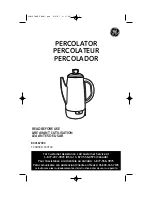
TROUBLE SHOOTING
CAUTION!
Always disconnect the unit from the
electrical power source before handling. If the system
fails to operate properly, carefully read instructions and
perform maintenance recommendations.
If operating problems persist, the following chart may
be of assistance in identifying and correcting them:
MATCH “CAUSE” NUMBER WITH
CORRELATING “CORRECTION” NUMBER
.
NOTE:
Not all problems and corrections are included.
PROBLEM
CAUSE
CORRECTION
Pump will not
run
1. Poor electrical
connection, blown fuse,
tripped breaker or other
interruption of power,
improper power supply.
2. Float is damaged,
dislocated.
3. Insufficient liquid level.
1. Check
all electrical
connections for
security. Check
for blown fuses,
tripped circuit
breakers or tripped
GFCI outlets.
2. Claim the
damage through
the carrier and
arrange for a
replacement unit.
3. Make sure liquid
level is at least
equal to suggested
turn-on point.
4. Recheck all
sizing calculations
to determine proper
pump size.
5. Check discharge
line for restrictions,
including ice if line
passes through or
into cold areas.
6. Replace with a
new check valve.
7. Open valve.
8. Clean impeller
and inlet of any
obstruction.
9. Check pump
temperature limits
& fluid temperature.
10. Replace portion
of discharge
pipe with flexible
connector.
11. Check for leaks
around basin inlet
and outlets.
Pump will not
turn off
2. Float is damaged,
dislocated.
4. Excessive inflow or
pump not properly sized
for application.
Pump hums but
does not run
1. Incorrect voltage
8. Impeller jammed or
inlet plugged.
Pump delivers
insufficient
capacity
1. Incorrect voltage.
4. Excessive inflow or
pump not properly sized
for application.
5. Discharge restricted.
6. Check valve stuck.
7. Shut-off valve closed.
8. Impeller jammed or
damaged, inlet plugged.
Pump cycles
too frequently
6. Check valve stuck.
11. Clean the basin and
inlet of any obstruction.
Pump shuts off
and turns on
independent of
switch, (trips
thermal overload
protector).
CAUTION!
Pump may start
unexpectedly.
Disconnect
power supply.
1. Incorrect voltage.
4. Excessive inflow or
pump not properly sized
for application.
8. Impeller jammed,
damaged, inlet plugged.
9. Excessive water
temperature.
Pump operates
noisily or
vibrates
excessively
5. Discharge restricted.
8. Impeller broken.
10. Piping attachments to
building structure too rigid
or too loose.





















